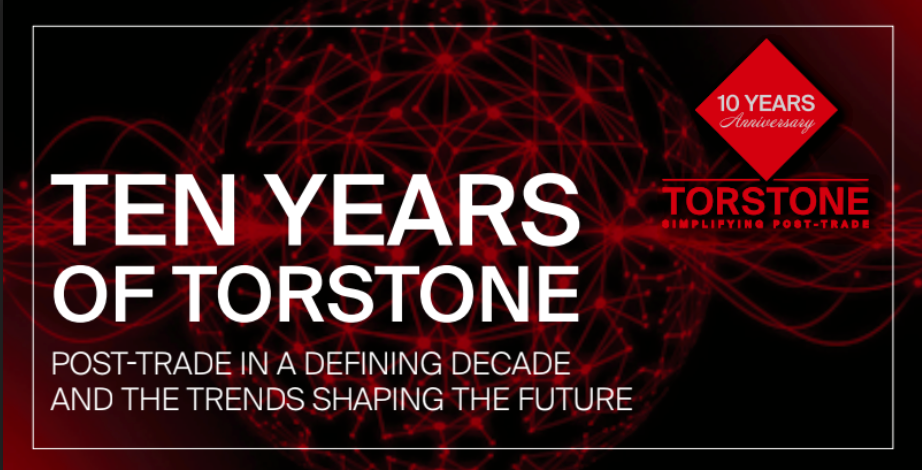
Ten years feels like a lifetime in financial technology. When we founded Torstone in 2011, the sell-side’s main focus was investment in the front office, largely leaving back-office functions to gather dust. We saw a problem that needed to be addressed, and with it, a significant gap in the market.
Why hadn’t another business tackled this problem before? The answer was simple – the barriers to entry were huge. Tackling post-trade systems means taking on multiple asset classes across jurisdictions, navigating the sprawling complexities of diverse regulations and instruments: a huge undertaking. Our background in developing these systems in-house across asset classes for a global investment bank gave us the knowledge on how to solve these problems for others, and our unique opportunity to leverage some of the IP we had developed for the bank gave us a head start in launching our platform. Out of this, Torstone was born.
A defining decade
Since we started our journey ten years ago, it’s been quite a ride as we have seen the sands of the post-trade landscape shift into something quite different today. A decade ago, institutions overwhelmingly relied on legacy systems that served as a bare minimum in servicing their post-trade needs, with many manual processes filling the gap. However, recognition of the importance of middle and back-office functions among sell-side firms has grown steadily, shifting institutions’ mindsets and elevating post-trade technology to an essential investment, not a requisite.
There have been a multitude of complex factors that have helped to shape post-trade, and for Torstone there have been four defining themes:
- The cloud: As the post-trade world has evolved, as have the technologies that support it. The cloud is a stand-out technology that has fundamentally changed the industry’s approach. Rewind ten years ago, uptake was low and there was hesitancy among larger institutions with concerns over security. The cloud has since proven to be a highly secure way of operating – it not only allows sell-side firms to process vast amounts of data but opens a new way of working, allowing us to service and improve post-trade systems remotely.
- Regulatory change: The imposition of new regulations such as Mifid II, their emphasis on post-trade reporting and the quality of data were a wake-up call for the industry. The enormity of the task of meeting these regulations turned attention to legacy systems and focussed minds on the urgent need to modernise to facilitate ongoing change.
- Automation: The unstoppable rise of electronic trading and the influx of market data has paved the way for greater automation of post-trade systems. Sophisticated programming and machine learning has put this vast body of information to good use – helping to automate the enormous volume of low-touch but time-intensive processes. In turn, improving efficiencies by allowing people on the desks to focus on higher value tasks.
- New asset classes: The growing number of asset classes has also changed the way we think of post-trade. Digital assets and the meteoric rise of ETFs, and their increasing adoption by institutions has been a challenge, requiring post-trade providers to find innovative solutions for emerging asset classes and anticipate new regulations.
A bright future
In finance, we will one day look back at the pandemic as a pivotal moment similar to the 2008 financial crisis. While a terrible human tragedy, for the technology that upholds our financial system, it was the ultimate test, not only managing the overnight shift in the way we work but a surge in volatility and transaction volumes. Powerful cloud-based technology kept many afloat, proving that technology is an essential pillar of modern finance and reinforcing the view of middle and back-office as vital functions.
Building on strong technological foundations, we can expect advancements in the cloud and automation as well as the development of new regulations and asset classes to continue to drive evolution in post-trade. Our job is to help clients future proof their systems and give them the flexibility to grow and adapt. As we recover and adapt to a post-pandemic world, we see three important trends already in motion that will usher the next era of post-trade services:
- Real-time data: The growing focus on the provision of real-time information, catalysed by the prospect of a shortened T+1 settlement cycle and new asset classes such as bitcoin or ETFs, is increasingly important to businesses. Real-time data flow allows firms to visualise their post-trade and risk data as it happens, handling and aggregating many thousands of trades per second from multiple sources to deliver usable insight to end users instantly. Not having this instant insight is to risk falling behind and being caught on the wrong side of moving markets and significant regulatory change.
- Consolidation: Simplicity and ease of use will be central to how clients approach post-trade technology. With increasing volumes, complexity, regulatory requirements and asset classes, disparate systems are no longer practical. Consolidation is another trend we see continuing, as institutions opt for a single operational interface through which they can simply manage their middle and back-office functions across all asset classes. Not only improving access to insights and information, but improving efficiencies, weeding out legacy systems not fit for purpose and giving organisations greater control over their middle and back-office functions.
- Increasing role of machines: Automation will continue to be an important theme as capabilities and applications expand. A significant amount of manual post-trade processes are already automated, yet we can expect its proliferation to continue, taking cumbersome tasks away from human operators and allowing them to turn their attention to higher-level tasks.
The next chapter
The post-trade space is anything but boring and we have an exciting and no doubt challenging decade ahead as we push for the next wave of innovations that will shape the banks and investment firms of the future. The global demand for modern post-trade services has taken Torstone from a small London-based startup to a global firm with well over a hundred people today across Europe, the Americas and Asia. The past decade’s rapid rate of change has shown how we, as a business, can not only adapt but thrive in a fast-paced market undergoing significant transformation. Our success is a result of the incredible hard work by our growing global team, so we celebrate our dedicated Torstone staff around the world as we set our sights on the next decade.




